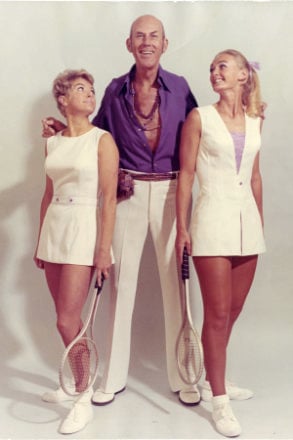LOS ANGELES — In 1949, tennis couture designer Ted Tinling was banned from Wimbledon for being racy. Tinling’s crime? He created lace tennis panties that American tennis player Gertrude Moran wore on the court.
Billie Jean King, however, loved Tinling’s provocative style.
In 1970, the first year of the women’s professional tour, Tinling — an out and proud gay man working during oppression decades — was selected as the designer for the newly formed Virginia Slims series. He designed more than 1,000 outfits for players, including one ensemble of sequins and rhinestones that King wore in her “Battle of the Sexes” competition against Bobby Riggs in 1973.

Pioneering tennis fashion designer Ted Tinling with two models in an undated photo. Photo: International Tennis Hall of Fame.
British actor Alan Cumming played Tinling in the 2017 film “Battle of the Sexes.”
Some of costumes featured in “Battle of the Sexes” are on display at the Fashion Institute of Design and Merchandising’s 26th annual “Art of Motion Picture Costume Design” exhibition.
Tinling “scandalized tennis because he would put lace under the shorts. The skirt would flip up, and gasp, there was lace,” said fashion designer Nick Verreos, a spokesman for the Fashion Institute of Design and Merchandising. “Ted Tinling was too escandaloso for Wimbledon.”
PROVOCATIVE FASHIONS
Standing 6-foot-7 inches, always impeccably dressed and fashionably adorned, Tingling designed tennis court fashions for nearly all the major female tennis players including King, who became a long-time friend.
Tinling’s creations were provocative, colorful, and revolutionary at time when most court fashions were predictable and dull. Tinling’s outfits ranged from the white cotton and clear plastic dress sported by Maria Bueno in the 1960s to the glittery outfits worn by King in the 1970s and 80s.
Black History Month: Lesbian musician Sister Rosetta Tharpe was godmother of rock ‘n’ roll
“Confidence is probably what makes the difference between a victory and a defeat,” said Tinling, according to the International Tennis Hall of Fame. “If a woman feels that she is prettier or better dressed than her opponent, nothing can stop her.”
INVITED BACK TO WIMBLEDON
Born in Eastbourne, England, on June 23, 1910, Tinling began his tennis career as a child when — on doctor’s orders — he went to the French Riviera to help alleviate his asthma. Tinling began playing the game and met the biggest tennis star of the time, Suzanne Lenglen.

In this scene from “Battle of the Sexes,” Emma Stone (Billie Jean King) and Alan Cumming (Ted Tinling) look at Tinling’s sequined outfit he made for King during her historic “Battle of the Sexes” match with Bobby Riggs. Photo by Melinda Sue Gordon/Twentieth Century Fox Film Corporation.
In 1927, Tinling’s friendship with Lenglen took him to Wimbledon, where he became player liaison for more than two decades.
Tinling coupled his love of tennis with fashion when he opened his own couture shop in 1931 London.
After the lace tennis-panties scandal at Wimbledon in 1949, Tinling was invited back to the All England Club in 1982.
Tinling authored two books on tennis, the most notable being “Love and Faults: Personalities Who Have Changed the History of Tennis.”
Tinling acted as liaison for both the Virginia Slims and the Women’s International Tennis Association and was inducted into the International Tennis Hall of Fame in 1986.
